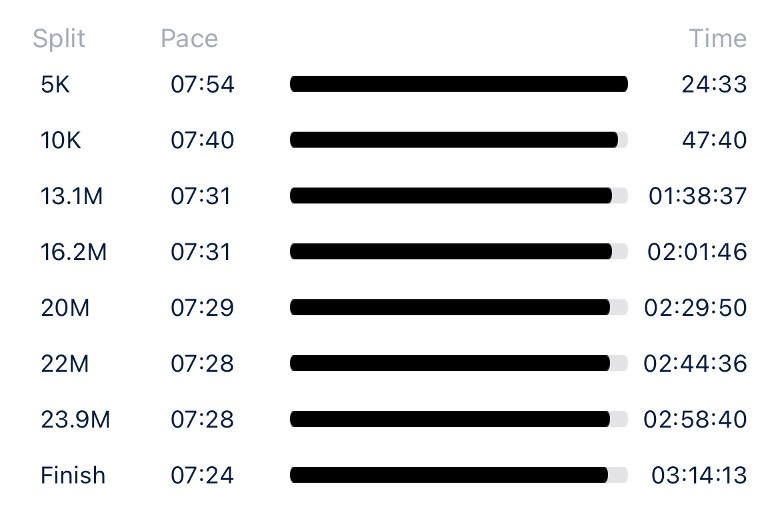If you’d have told me at any point during my collegiate basketball career that I would run a marathon in the next 10 years, I would’ve looked at you as if you had grown an extra arm and maybe another leg to go along with it.
Fast forward to Saturday (6/21/2025) and I’m now a proud carrier of a marathon finisher medal.
Which of course is the only reason to ever sign up (& pay) to run 26.2 miles.
Race Breakdown
There were many different strategies I considered as a novice running my first marathon, but I settled on starting relatively easy and seeing where my legs were at after ~5 miles.
A common strategy for first-time runners.
The last thing I wanted to do was get 15 miles in, be completely cooked, and bonk out of my first long race.
So what I did was locate the 3:30 pacer — an individual carrying a sign showing that he was running at an 8 minute per mile pace — and coast alongside him for a few miles.
As you can see below, I felt reasonably comfortable at this pace and then began speeding up. This is typically referred to as a negative split — gradually running faster throughout the course of the race.
Thankfully my body was able to hold up (although not without some bumps and bruises) and I finished at a 3:14:13 — clocking in at ~7:24 per mile on average.
Beating my goal time by a whopping 47 seconds.
Training Breakdown
Although it wasn’t perfect — far from it in fact — I followed a 16-week training program.
It helped tremendously that I entered this training block with a relatively good endurance base running close to 15 miles per week on average prior to officially starting the plan.
The setup would have been vastly different had I not been running consistently prior. There’s an important lesson in that.
As you can see from a brief snapshot below, I held a solid base prior to slowly increasing my weekly mileage from 15 miles up to 35 miles over the 16-week period.
Logistically, this typically included a long run (my last was 20 miles), two or three Zone 2 base runs of 5-8 miles, and a speed/tempo workout pushing into higher heart rate zones.
Even though some overindulge in the exact breakdown and nuances, it really isn’t rocket science.
But on the bottom image you can also see a complete plummet down the mountain in the month of June.
Thanks to a shin injury, I completely shut down running and opted for biking and other activities to hold on to as much fitness as I could without causing further damage in order to avoid having to pull out of the marathon.
Let’s just say entering the race with a total of 11 miles ran over the previous ~5 weeks wasn’t the most mentally comforting.
More on that to come.
Diet Breakdown
This is one of the areas I feel put me ahead of the curve.
Keep reading with a 7-day free trial
Subscribe to Healthy in Bulk to keep reading this post and get 7 days of free access to the full post archives.







